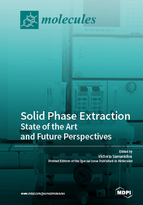Solid Phase Extraction: State of the Art and Future Perspectives
A special issue of Molecules (ISSN 1420-3049). This special issue belongs to the section "Analytical Chemistry".
Deadline for manuscript submissions: closed (28 February 2019) | Viewed by 59054
Special Issue Editor
Interests: analytical chemistry; sample preparation; chromatography; HPLC; method validation; method development; separation science; food analysis; bioanalysis; environmental analysis; green analytical chemistry; sorptive extraction; microextraction techniques
Special Issues, Collections and Topics in MDPI journals
Special Issue Information
Dear Colleagues,
Beyond any doubt, sample preparation is the most important step prior to sample analysis. It is the step that can guarantee an accurate and rapidly obtained result if applied in a correct manner. Due to the fact that it usually involves more than one step, it is tedious, time consuming, and any potential errors will accumulate and yield an erroneous outcome.
Solid phase extraction (SPE) has been a determinative player in the challenge of chemical analysis during the last decades. In the meantime, many sample preparation approaches have been evolved trying to replace it by promising better and “greener” performance. However, SPE still plays a key role in method development, and advanced sorbent technology can re-orient the traditional approach to new perspectives. This Special Issue aims to review the state of the art of this sample preparation technique and also describe the recent and future advances.
Prof. Dr. Victoria F. Samanidou
Guest Editor
Manuscript Submission Information
Manuscripts should be submitted online at www.mdpi.com by registering and logging in to this website. Once you are registered, click here to go to the submission form. Manuscripts can be submitted until the deadline. All submissions that pass pre-check are peer-reviewed. Accepted papers will be published continuously in the journal (as soon as accepted) and will be listed together on the special issue website. Research articles, review articles as well as short communications are invited. For planned papers, a title and short abstract (about 100 words) can be sent to the Editorial Office for announcement on this website.
Submitted manuscripts should not have been published previously, nor be under consideration for publication elsewhere (except conference proceedings papers). All manuscripts are thoroughly refereed through a single-blind peer-review process. A guide for authors and other relevant information for submission of manuscripts is available on the Instructions for Authors page. Molecules is an international peer-reviewed open access semimonthly journal published by MDPI.
Please visit the Instructions for Authors page before submitting a manuscript. The Article Processing Charge (APC) for publication in this open access journal is 2700 CHF (Swiss Francs). Submitted papers should be well formatted and use good English. Authors may use MDPI's English editing service prior to publication or during author revisions.
Keywords
- Solid phase extraction
- Microextraction
- Green Chemistry
- Sample preparation
- Preconcentration
- Clean-up
- Microextraction by packed syringe
- Matrix solid phase dispersion
- Nanomaterials
- Magnetic solid phase extraction
- Dispersive solid phase extraction
- Magnetic sorbents







